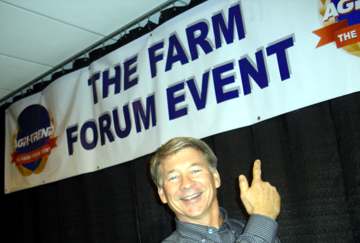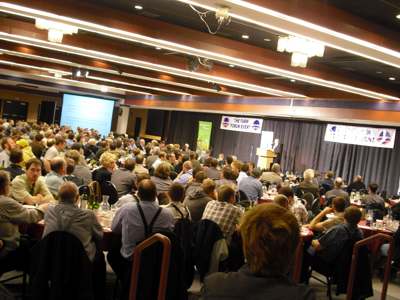

The TCU Place conference hall in the center of Saskatoon, Canada was the location of the Agri-Trend 2009 Farm Forum Event held November 18 and 19. With about 1200 leading farm producers from across the Canadian prairies in attendance, this year’s theme was ‘Harvest A World of Ideas.’
Operated by the Agri-Trend group of companies that includes Agrology – agrology, Aggregation – carbon offsets, Marketing – marketing strategies and Data – data management platforms, the event pulled together interested parties from each of these areas of focus. The program was international in scope with presentations from Australia, South America, Europe and North America.
Rob Saik, CEO, Agri-Trend Group opened the show welcoming those in attendance before Dr. Roel Jongeneel of The Netherlands gave the inital keynote ‘Will the World Have Enough to Eat?’ His point was straight forward, the world’s population is increasing and a high level of food production will be necessary to meet the challenge. New agricultural research, approaches to agriculture and sustainable farming methods will ensure a maximisation of production.
There was a large presence of partners at this year’s event that included Monsanto, Dupont, John Deere, Scotia Macleod, JR Simplot, Omex, Mercantile Venture, Conterra Seeds, Bayer Crop Science, A & L Labs, Pattison Liquid Systems, Seedmaster, Trimble, Seed Hawk, Raven / Ranchview and Wigmore.
 With eight concurrent sessions running it was difficult to choose which presentations to attend. Gregg Patterson of A&L Labs spoke on the subject of Nutrient Use and Efficiency and Root Uptake.
With eight concurrent sessions running it was difficult to choose which presentations to attend. Gregg Patterson of A&L Labs spoke on the subject of Nutrient Use and Efficiency and Root Uptake.
He pointed to the improvements in lab analysis for soil samples and some of the new tests that take into account nitrogen to micronutient ratios.
He indicated that a key goal is to establish healthy plant roots and provided several examples of tests that showed how and why crop production was limited.
Warren Bills is Geo-Coach at Agri-Trend and his presentation was on the topic of precision farming as it relates to remote sensing. Bills said that the company was having initial successes with RapidEye imagery on the prairies and that another imagery product from Real Shot Imagery was also being used. Both services were being offered for under $10 CDN per acre. His colleague Simon Knutson spoke on the topic of precision drainage. He pointed to the use of GPS equipment for generating digital terrain models (DTM) and indicated that the concept was to enact efficient drainage upon farmland and thereby increase the possibility of bringing marginal land into production.
VIDEO: Precision Farming Demonstration – Mapping and fungicide treatment. (Video by Terry Aberhart of Aberhart Farms, Saskatoon, Canada – 60Mb)
Bill Dorgan of Agri-Trend Aggregation gave an interesting presentation that discussed the current state-of-play for carbon credits in Canada as they relate to agriculture. He said that the current marketplace abounds with different acronyms, but the Carbon Offset Trading Association (COTA) provided suitable titles. At present, only the province of Alberta has carbon offsets legislation in place for agricultural production, but it was anticipated that Saskatchewan would soon follow and probably be based on a similar legislation as Alberta.
Dorgan said that Alberta had a carbon capacity of about 223 million tonnes per year as of 2004. Only Large Format Emitters (LFE) are eligible to offset credits within Alberta and under the Act, the LFE must purchase these within Alberta. In other words – carbon trade has a geographic component within the province. Interestingly, he indicated that the Alberta Tar Sands account for only 18% of total Alberta carbon production. Seveal thrusts were described, these include :
The Alberta carbon solution involves rigid verification through certified accounting. It also involved detailed field validation, thus necessitating the further need for digital farming systems that can provide accurate landscape details spatially and quantifiably.
In at least one category, the Act considers actual conservation farming practices and minimum tillage requirements.
Roberto Pieretti of Global Farming Systems, Argentina delivered the second keynote of the event. He described a global sustainable model for agricultural production. He said:
Vince Restucci of JR Simplot delivered a presentation on the topic ‘The Digital Farm 2.0.” He pointed to the rising tide of traceability and verification within the production of food across the chain – production to delivery. Restucci indicated that data handling and digitisation of records is a good first step toward meeting these challenges. This supports current trends toward integrating agriculture within geospatial technologies and mapping systems.
The transport of agricultural production within Canada is a touchy subject and stirs many emotions. That is because the railroads have long been supported through various strategies by the government as a way to move grains to ocean ports. There are several reasons for the changes over the years and Perry Pellerin of GNP Consulting Ltd explained the relationship of government funding to farmer expectations and the railroad operations.
This was a fascinating presentation dating back to 1897 where the government entered into an agreement with railroads to transport grains – for life – for the grand sum of $3.4 million CDN. Later the cost of shipping would rise above revenues and the railroads would evolve new approaches for gaining funding to deliver grain. In short, transport costs have risen from $5.60/tonne CDN in 1983 to $42.00/tonne CDN in 2009. And, the number of grain cars has been reduced and will continue to lower, thereby taking the whole issue back to 1897 to begin the cycle over again.
Pellerin showed many maps that described the reduction in rail lines across the prairies asking, “are farmers paying more for less than they were a 100 years ago?” His point was well taken.
Andrew Trottier of Australia gave an interesting presentation on agriculture within Australia. His keynote address pointed to the difficulties that Australian farmers face with respect to farming practices, climate and water related issues. Crops in that country grow slow, very slow, as the climate moderates from warm to cold to warm again. In some cases they can take 25 days to emerge from the soil with a frost damaging period occurring during August to September. As soils warm, they dry out. That poses particular difficulties for soil nutrient management.
Many of the soils are old, in the order of millions of years and the organic matter content is less than 2.5% and they have high degrees of compaction. These soils are potassium rich but are often too acidic. Only recently have farmers looked at the lack of plant available sulphur, often focusing upon phosphorus.
There are current issues with magnesium and copper in Australian agricultural soils that are limiting production and in need of more research. Finally, very few of the farmers in that country actually soil test and if they do, then it is only on or near the surface. This departs dramatically from other parts of the world.
Hendrik Feenstra was 12 when he passed the CCA – Canadian Certified Agricultural consultant examine. He passed both regional and international tests. Now 13, he lives near Nobleford, Alberta with parents Jack and Anne Marie who emigrated from The Netherlands a while back. He gave a presentation to 1200 people entitled “How to feed the world on 2 acres of land” – outlining his plan that used sustainable farming methods, renewable energy sources and liberal use of compost etc. Well done Hendrik!
Elston Solberg, president of Agri-Trend Agrology spoke on the topic of ‘Getting More Bang for you Analytical Buck.’ Solberg, an internationally experienced agronomist, identified the large number of resources within Canada available to farmers to tap, such as CANSIS, the Canadian Soil Information System. He said that agricultural production demanded more attention to sampling soil and plant tissues as they were indicators of healthy, profitable production in a sustainable fashion.
With nitrogen fertilizer at nearly $1 CDN per 0.5 kg alone, efficiency was the name of the game Solberg said. For all appearances costly fertilizer will continue and that farmers must learn to adapt their management strategies to a more sustainable basis that takes inputs into account in a more holistic way.
Overall the event was well attended, expanding from 2008 and indications are that it will grow again in 2010.
——————————————————————————
Additonal blog reports on the conference:
GPS & Terrain Models — Precision Drainage Management
Farm Forum Conference Opens in Saskatoon, Canada